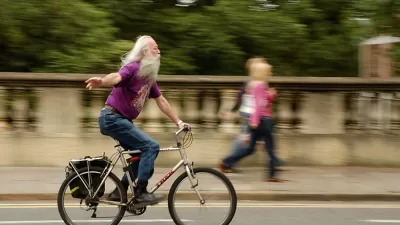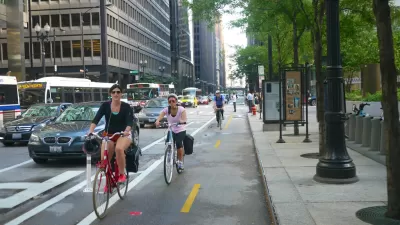The take of a large culture publication like Atlanta magazine can be helpful in assessing the traction of a movement—in this case, biking in the city of Atlanta.
If the number of cyclists here seems to be increasing, that’s because it is," writes Andesheh Nouraeh.
In fact, "[between 2000 and 2009, Atlanta (the city, not the metro area) registered the country’s highest increase in bike commuting." And that was before the initial sections of the BeltLine opened, which provides a beautiful and popular bike facility for residents of Atlanta.
Nouraen goes on to provide insight into the current planning and advocacy discussion about how the city might continue to improve its bicycle infrastructure: "As more cyclists arrive, the city is trying to accommodate them. Speaking to the Atlanta Bicycle Coalition’s commuter breakfast in August, Jonathan Lewis of the city’s planning and transportation department said additional bike lanes are included in Atlanta’s comprehensive infrastructure bond issue that will face a referendum next year. While the total has not been finalized, the coalition is petitioning for $37 million in cycle-related improvements, which it claims could add an additional 100 miles of bike-friendly roadways."
The article acts as a brief primer for people who might not be informed about all the infrastructure, social, and political issues surrounding. The article celebrates the joys of biking and provides road configuration diagrams, but it also has to spend some time in a defensive stance by indicting the behavior of what a source cited in the article calls "dude bros": "people whose aggressive riding, disregard for the rules of the road, and confrontational attitude can turn drivers against all bike commuters."
FULL STORY: Can Atlanta, a city built for cars, make room for bikes?

Alabama: Trump Terminates Settlements for Black Communities Harmed By Raw Sewage
Trump deemed the landmark civil rights agreement “illegal DEI and environmental justice policy.”

Planetizen Federal Action Tracker
A weekly monitor of how Trump’s orders and actions are impacting planners and planning in America.

The 120 Year Old Tiny Home Villages That Sheltered San Francisco’s Earthquake Refugees
More than a century ago, San Francisco mobilized to house thousands of residents displaced by the 1906 earthquake. Could their strategy offer a model for the present?

In Both Crashes and Crime, Public Transportation is Far Safer than Driving
Contrary to popular assumptions, public transportation has far lower crash and crime rates than automobile travel. For safer communities, improve and encourage transit travel.

Report: Zoning Reforms Should Complement Nashville’s Ambitious Transit Plan
Without reform, restrictive zoning codes will limit the impact of the city’s planned transit expansion and could exclude some of the residents who depend on transit the most.

Judge Orders Release of Frozen IRA, IIJA Funding
The decision is a victory for environmental groups who charged that freezing funds for critical infrastructure and disaster response programs caused “real and irreparable harm” to communities.
Urban Design for Planners 1: Software Tools
This six-course series explores essential urban design concepts using open source software and equips planners with the tools they need to participate fully in the urban design process.
Planning for Universal Design
Learn the tools for implementing Universal Design in planning regulations.
Clanton & Associates, Inc.
Jessamine County Fiscal Court
Institute for Housing and Urban Development Studies (IHS)
City of Grandview
Harvard GSD Executive Education
Toledo-Lucas County Plan Commissions
Salt Lake City
NYU Wagner Graduate School of Public Service




























